Smart B2B Sales Strategies Win More Clients

So, you're diving into B2B sales, huh? Grab a coffee (maybe something stronger) and get comfy. B2B sales isn’t exactly a casual stroll in the park – it’s more like swimming with sharks (the well-dressed, corporate kind). But don’t worry! With the right strategies, you can turn those shark-infested waters into your own profitable aquarium.
In this guide, we’ll covert what B2B sales really means, how the process works, share some battle-tested tips and examples, and dish out the best strategies to grow your business in 2025. And we’ll do it all in a friendly, conversational tone – as if we’re two colleagues swapping stories over lunch. Ready? Let’s dive in.
What Is B2B Sales?
B2B (Business-to-Business) sales means one business is selling products or services to another business (basically, companies buying from other companies rather than individual consumers).
For example, imagine a paper manufacturer selling bulk paper to a printing company, or a software startup providing an app to a Fortune 500 firm. Those are classic B2B sales scenarios. In B2B, your “customers” aren’t single folks browsing Amazon; they’re organizations with multiple people involved in the buying decision.
A few things make B2B sales a unique beast:
- Higher stakes and price tags: B2B deals often involve larger dollar amounts or big-volume purchases. (It’s like selling a truckload of coffee beans to a chain of cafés versus a single latte to one person.)
- Longer sales cycles: Instead of a quick impulse buy, B2B sales are a slow courtship. There are usually multiple meetings, product demos, and negotiations. Think Netflix series (with many episodes) rather than a short TikTok video – patience is key.
- Multiple decision-makers: In B2B, you’re usually not convincing just one person. You might have to get the thumbs-up from a manager, a finance director, and the CEO’s cousin’s dog (okay, slight exaggeration). On average, a B2B purchase involves a committee of 6 to 10 stakeholders weighing in.
- Complex processes: Because of the above factors, B2B sales require a team of skilled salespeople and often a structured process to shepherd deals from start to finish. There may be RFPs (requests for proposal), legal reviews, and other fun paperwork. It’s rarely “sold on the spot” – more often, it’s a series of discussions and follow-ups before the deal is sealed.
In short, B2B sales is about business relationships. You’re solving big problems for companies, which means if you succeed, you’re not just making a one-time sale – you’re potentially landing a long-term client that could be worth a lot to your business.
How the B2B Sales Process Works
Think of the B2B sales process as a journey with a set of stops along the way. While every company’s approach will vary a bit, most B2B sales cycles follow a similar roadmap. Here’s an example of a 6-stage B2B sales process and what happens in each step:
- Do Your Homework (Conduct Research): Before reaching out, understand your market, competitors, and who your ideal customer is. It’s like checking the GPS before hitting the road—you don’t want to get lost (or pitch to the wrong crowd).
- Find Your People (Lead Generation): Time to scout for potential buyers. Use LinkedIn, industry events, referrals, and tools like Sales Navigator. Basically, find companies and decision-makers who could use what you’re offering.
- Say Hello (Conduct Outreach): Reach out—email, call, DM—but don’t be a robot. Personalize your message and show you get their business. It’s about starting a convo, not making a sale right away.
- Show the Goods (Pitch the Lead):Here’s where you present your solution like a doctor with a prescription—solve their specific pain point. Keep it focused, consultative, and helpful. No feature dumps.
- Keep in Touch (Follow Up): Most deals don’t close on the first try. You’ll need multiple follow-ups—friendly nudges, added value (like case studies), and patience. Stay top of mind without being annoying.
- Seal the Deal (Close the Sale): Time to finalize! Be ready for last-minute negotiations or legal hurdles. Once the paperwork’s signed, it’s “Closed-Won.” Deliver what you promised and prepare for the next phase: keeping them happy.
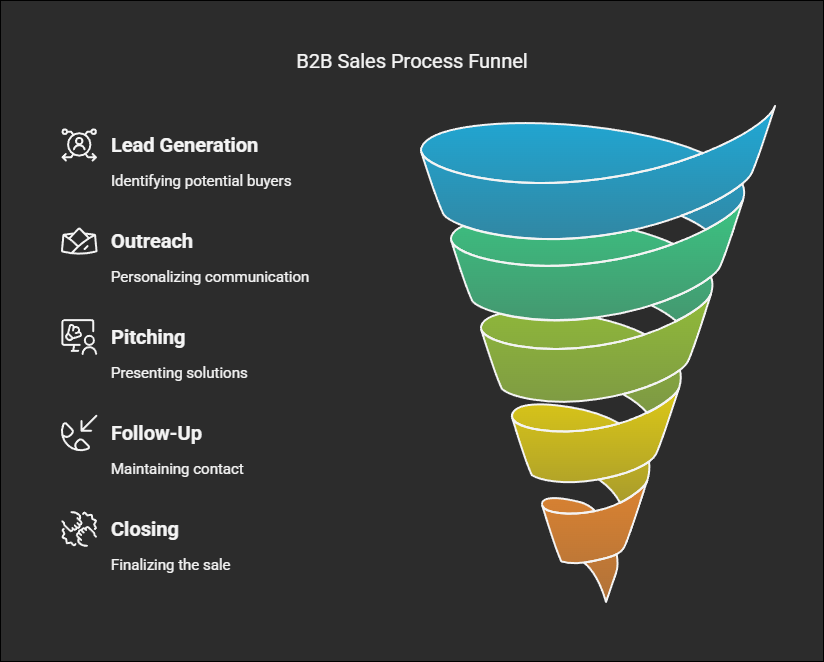
Tips to Do Successful B2B Sales
Ready for some pro tips? Whether you’re a newbie or a seasoned sales veteran, these core principles will help you level up your B2B sales game. Let’s break down some essential tips (in plain English) for closing more deals and building great B2B client relationships:
💡 1. Personalize Everything
No one likes being treated like a walking wallet. Do your homework, tailor your pitch, and make each prospect feel like they’re your one and only (even if they’re not). Bonus points for using tools that automate personalization at scale.
👂 2. Listen More Than You Talk
Let your prospect vent, rant, and reveal what really matters to them. Your job? Ask smart questions, shut up, and take notes. Listening = understanding = better sales.
💰 3. Don’t Let Price Scare You
If your product is valuable, own it. Shift the focus from cost to ROI. Confidently show how your solution pays off, and avoid the trap of being the “cheapest option.” (Nobody wins the race to the bottom.)
📊 4. Embrace Tools & Data
Track what’s working, ditch what’s not, and use tech to get smarter. CRMs, automation, and AI can be your best sales buddies—so use them to streamline, strategize, and stay ahead.
🧠 5. Keep Learning
Sales isn’t a “set it and forget it” gig. Keep your skills sharp through regular training, team huddles, and staying in the loop on industry trends. A well-trained team = a high-performing one.
🤝 6. Be a Consultant, Not a Pitch Machine
Approach each convo like a helpful advisor, not a walking billboard. If your solution isn’t the best fit, be honest. Build trust, give insights, and aim to solve—not just sell.
🔁 7. Nurture Those Relationships
Deals take time. Stay in touch with leads who aren’t ready yet and keep engaging even after you’ve closed. A happy client = future business, referrals, and bonus high-fives.
Examples of B2B Sales

Let’s bring this to life with a few concrete examples. B2B sales come in different flavors depending on the industry and business model. Here are three common types of B2B sales, with examples of each:
Supply Sales
One business sells consumable goods (like office supplies or raw materials) to another. Think bulk orders and repeat purchases. Example: Lyreco supplying office products to large companies, or Mallory Safety providing gear to factories. It’s all about volume and ongoing relationships.
Wholesale/Distribution Sales
Wholesalers sell goods in bulk to businesses that either resell them or use them in production. Example: Alibaba connecting manufacturers to retailers, or food distributors selling to restaurants. The goal? Lower unit costs, bigger orders, and no end-consumers involved.
Services/Software Sales
Instead of products, these deals involve services or software. Think SaaS, consulting, cloud hosting, marketing. Example: QuickBooks selling accounting tools to businesses or a tax firm advising a corporation. The focus here? ROI and efficiency—helping clients save or make money.If a business pays another business to help it operate—whether it’s buying paper, phone cases, or project management software—it’s B2B.
What Is a B2B Sales Funnel?
You might have heard the term “sales funnel” thrown around in marketing meetings. It’s not a literal funnel, but it’s a useful metaphor to understand the stages a potential B2B customer goes through before they become an actual customer (and beyond). Picture a funnel shape: wide at the top (lots of people who might be prospects) and narrow at the bottom (the few who actually buy).
A B2B sales funnel tracks the buyer’s journey through different stages, typically:
1. Awareness
The prospect realizes they have a problem and discovers your company as a potential solution—maybe through a blog, LinkedIn post, or event. They're just browsing, so your goal is to grab their attention with helpful, memorable content.
2. Interest
Now they're engaging—following your page, signing up for emails, or downloading resources. They're curious if you can help. It’s your job to nurture this interest with answers, case studies, or an initial discovery call.
3. Consideration
They’re seriously evaluating options, including your competitors. This is demo/proposal time. Multiple stakeholders may get involved. Your focus: highlight your unique value, answer deep questions, and address concerns.
4. Decision
The prospect is almost ready to buy but may have final doubts—price, integration, ROI. Reassure them with testimonials, case studies, or negotiation as needed. Ideally, they choose you.
5. Purchase
Contract signed, deal done! They become a customer and begin using your solution. 🎉 But it’s not over—now comes the real test.
6. Evaluation
The customer judges if your product lives up to the promise. Good onboarding, results, and support are critical here. Check in to ensure they’re getting value.
7. Satisfaction/Dissatisfaction
If satisfied, you gain a loyal customer—and maybe a referral. If not, listen to feedback and try to fix things fast to avoid regret or churn.
8. Repurchase/Attrition
A happy customer may renew, upgrade, or refer others. An unhappy one may walk. Your goal: turn that first sale into a long-term relationship.
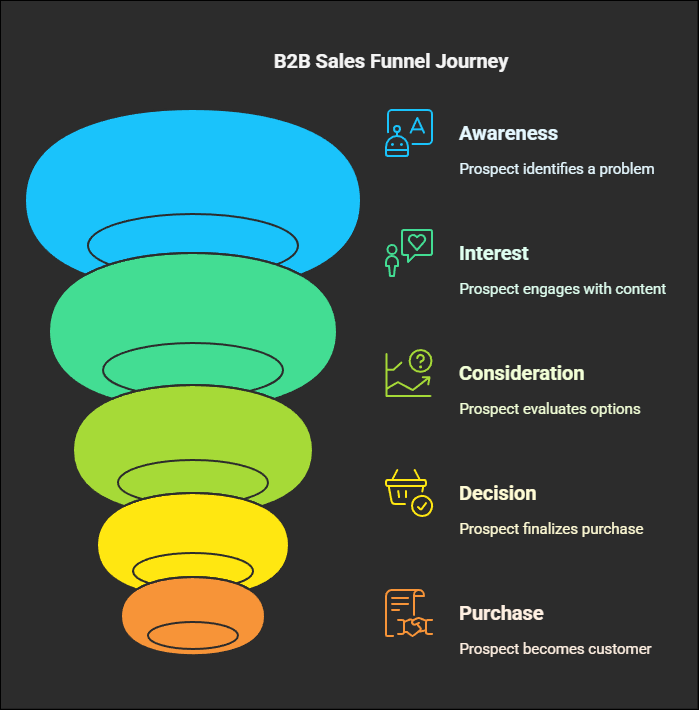
Difference Between the B2B Sales Funnel and Sales Process
Now, you might be wondering – “Sales funnel, sales process… aren’t they the same thing?” They’re related, but not identical. Think of it this way:
- The sales funnel is from the buyer’s perspective. It visualizes the buyer’s progress toward a purchase (and beyond). It’s outward-facing. When we talk about funnels, we talk about stages like awareness, consideration, decision, etc., and how many people make it through each stage (conversion rates).
- The sales process is from the seller’s perspective. It’s the series of steps your team takes to move a deal from prospect to close. It’s inward-facing. Stages like research, outreach, pitch, follow-up, close – those are part of your internal process.
Another way to put it: the sales process is your game plan, and the funnel is how you measure progress of leads through that plan.
Let’s highlight a few key differences:
- Focus/Viewpoint: The sales process is brand-focused (what we do to sell) whereas the sales funnel is customer-focused (what they experience when buying). The process looks at activities (e.g., “send proposal” or “schedule demo”), and the funnel looks at conversion (“prospect requested a demo” -> “prospect is evaluating solutions”).
- Measurement: A sales process is often measured in terms of activities completed and pipeline status. For example, your CRM might show 10 deals in the “Proposal Sent” stage – that’s process-oriented. A sales funnel is measured in terms of conversion rates between stages. For instance, “20% of leads who downloaded our whitepaper (Awareness) ended up requesting a demo (Consideration)” – that’s funnel conversion data. Both are useful: the process measures efficiency and execution, and the funnel measures effectiveness and drop-off points.
- Management: Sales managers often use the sales process to manage their team’s efforts. They’ll ask, “How many calls were made? How many demos this week? What’s the status of Deal X?” That's the process. In contrast, strategists or marketers might look at the funnel to identify bottlenecks. “We need more leads at the top of the funnel” or “We’re losing a lot of prospects at the proposal stage – why?” Funnel analysis can prompt those questions and improvements to either the sales or marketing approach.
The sales process is the set of actions your team takes, and the sales funnel is a way to track and analyze prospects’ movement toward a sale. They’re two sides of the same coin. A smooth sales process helps push people down the funnel, and understanding the funnel can help refine the sales process. Smart organizations pay attention to both.
Best B2B Sales Strategies
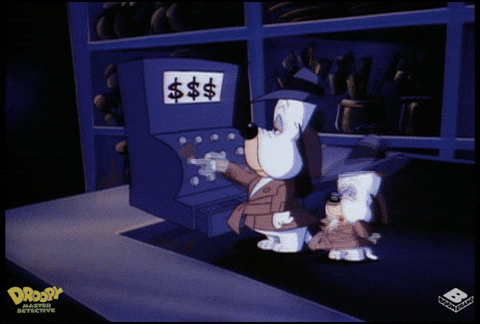
Let’s talk strategy. Beyond general tips and definitions, what specific strategies can you use to crush it in B2B sales? Here are four proven B2B sales strategies (with fancy names) that companies use to boost their win rates, along with what they actually mean in practice:
1. Strategic Selling
Used for complex deals with multiple stakeholders. You identify key players (decision-makers, influencers, champions) and tailor your approach to each. It’s a long-game, insight-driven strategy that requires planning but increases the odds of closing large, intricate deals.
2. Solution Selling
Focuses on solving a customer’s specific problem, not just selling a product. It’s consultative—understand their pain, then position your offering as the remedy. Customization and active listening are critical. Great for high-value, needs-based sales, but can be time-consuming.
3. Account-Based Selling (ABS)
You go after a few high-value accounts with laser focus. Sales and marketing work together to deeply personalize campaigns for each target company. It’s a multi-channel, relationship-building strategy ideal for big deals where one win can outweigh dozens of small ones.
4. Social Selling
Build relationships through platforms like LinkedIn. Share valuable content, engage with prospects, and establish credibility before initiating a sales conversation. It’s about networking, not pitching—warming up leads through genuine interaction.
Pro tip: These strategies can be combined. Tailor your mix based on deal size, complexity, and buyer behavior to get the best results.
How to Generate Leads
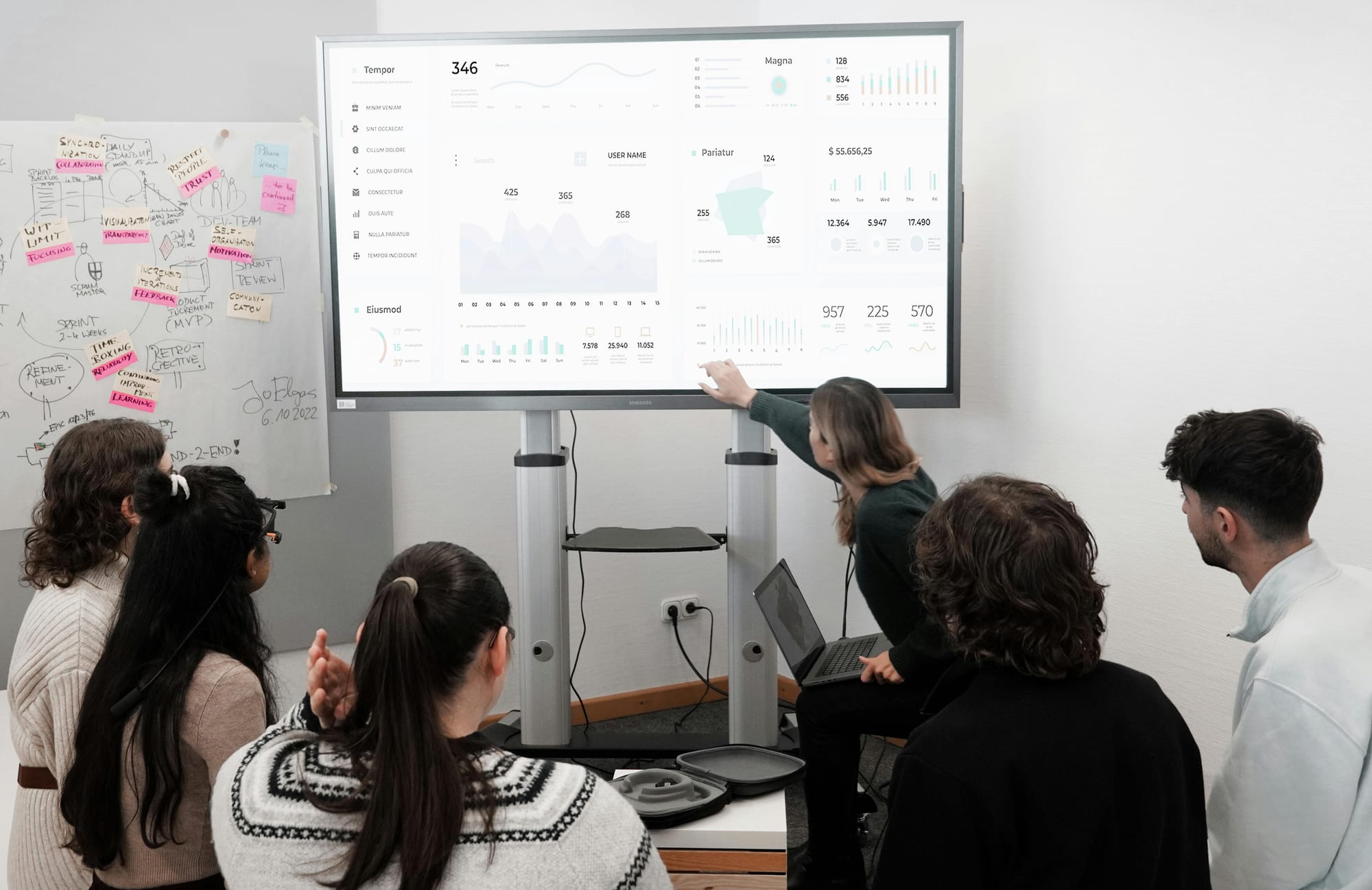
No leads, no sales – it’s as simple as that. Generating a steady stream of quality B2B leads is one of the most important (and challenging) parts of growing a business. How can you find more potential customers to fill that funnel? Here are some effective methods to generate B2B leads in 2025 (and how to make the most of them):
1. Use Live Chat on Your Website
Live chat (with humans or AI) helps engage visitors in real time, especially on high-intent pages like pricing. Quick responses increase conversion chances—replying within 5 minutes makes leads 9x more likely to engage. Use chatbots after hours to collect contact info for follow-up.
2. Master Outbound Calling
Cold calling isn’t dead—it just needs strategy. Use call scripts (naturally), aim to book meetings (not hard-sell), and qualify leads before dialing. Timing matters, so call smart. Integrate calls with your CRM to track progress and follow-ups.
3. Offer Quality Training
Train both your sales team and your prospects. A sharp team converts better. Hosting free webinars or educational sessions also attracts leads while showcasing your value. Just make sure the content is genuinely helpful.
4. Align Sales and Marketing
Avoid the “blame game” by getting sales and marketing to agree on what a qualified lead is. Create shared definitions (like SLAs), communicate regularly, and use shared dashboards. Collaboration leads to better lead handoff, follow-up, and results.
5. Do Smart Targeting Through Research
Quality beats quantity. Research your prospects before outreach—know their industry, pain points, and recent news. Personalized, informed messaging resonates more and builds trust faster. Use tools like LinkedIn and news alerts to stay sharp.
Final tip: Use a mix of these strategies. Monitor what works, double down on high-performing channels, and always be refining your approach. Lead gen is a balance of art, strategy, and staying human.
B2B Sales Challenges

Let’s be real: B2B sales isn’t all rainbows and high-fives. There are plenty of challenges and roadblocks that can trip you up on the way to closing deals. The good news is, once you know what these common challenges are, you can plan for them (and overcome them). Here are some big B2B sales challenges and how to tackle each:
1. Lack of Content
In the early stages of a B2B sale, prospects are usually looking for information before they even consider talking to a salesperson. They want to understand your solution, see how it’s worked for others, and evaluate whether you’re credible. If your company has little or no online content—such as blog posts, case studies, whitepapers, or testimonials—it raises red flags. A buyer might think, “If I can’t find anything about them, can I really trust them?” Lack of content often equals lack of trust.
The Fix: Build a content library that educates and solves real problems. Create helpful resources like how-to guides, case studies, and success stories to support sales and build trust. Share this content in follow-ups and make it easy to find on your site, LinkedIn, and emails—it’s more than marketing, it’s a credibility booster.
2. Prolonged Sales Cycle
B2B sales often involve multiple decision-makers, budget approvals, and rounds of discussions. This can stretch the sales cycle out for weeks or even months. Long sales cycles eat up time and resources, and they increase the chances of deals going cold or stalling out completely. You might feel like everything’s going well, only to hear, “Let’s revisit this next quarter.”
The Fix: Qualify leads early to avoid wasting time on dead ends. Once engaged, stay patient and persistent—use CRM tools to track follow-ups and keep adding value with helpful content. Always end meetings with clear next steps to maintain momentum in the sales process.
3. Data Overload
Today’s sales teams and buyers are drowning in data. Between detailed product specs, performance metrics, competitor comparisons, and dozens of marketing assets, it’s easy to overwhelm prospects. The same goes for your sales reps, who can get lost in dashboards and reports, making it harder to stay focused on what really drives deals forward.
The Fix: Keep it simple and tailored. Share content that matches each stakeholder’s priorities—like ROI for a CFO or tech details for IT. Use visuals, summaries, and real-world examples to make your message clear. Internally, focus on key metrics and avoid data overload. Clarity beats quantity every time.
4. Lack of Customer Confidence
The Problem: B2B deals often involve risk—financial, reputational, or operational. Your prospect is asking themselves, “What if this doesn’t work?” or “What if I recommend this and it backfires?” Fear of the unknown can be a major roadblock, especially if they’ve had a bad experience switching vendors or implementing new software in the past.
The Fix: Build buyer confidence with trust and proof—use specific testimonials, case studies, and offer trials when possible. Be transparent about your process, address concerns directly, and connect prospects with happy clients. The more you reduce perceived risk, the more likely they are to say yes.
5. Technological Deficiency
The Problem: If your sales team isn’t using the right tools, they’re working harder than they need to—and possibly losing leads along the way. Relying on spreadsheets, manual data entry, and old-school processes makes it easy to drop the ball on follow-ups, lose track of opportunities, and waste valuable time.
The Fix: Invest in sales tech to boost efficiency—start with a solid CRM, then add tools to automate tasks like emails and scheduling. Use AI to support, not replace, your reps, so they can focus on selling. Train your team well, start small, and scale up as you see results. Smart tech = smarter sales.
How to Measure KPIs

You’ve set up your sales strategies and you’re generating leads – great! But how do you know if all this effort is actually paying off? That’s where KPIs (Key Performance Indicators) come in. KPIs are the metrics that help you evaluate the performance of your sales activities and outcomes.
In B2B sales, there are a ton of things you could measure, but let’s focus on some of the most important KPIs and how to measure them effectively. Keeping an eye on these will tell you what’s working, what’s not, and where to make adjustments in your strategy.
Here are some crucial B2B sales KPIs to track:
1. Sales Productivity Metrics
What it tells you: How your reps spend their time and how efficiently they move deals forward.
Why it matters: Many reps spend less than 30% of their day actually selling. The rest goes to admin tasks, meetings, and CRM updates. Tracking productivity metrics (like calls made, meetings held, demos delivered, and time spent in each sales stage) reveals where time is being lost and where processes can be improved.
How to use it: If you see that deals are getting stuck in the "Evaluation" stage or too much time is going to non-revenue activities, explore solutions like automation tools or sales enablement support to free up reps’ time.
2. Revenue Metrics
What it tells you: How well your sales activities are translating into business growth.
Why it matters: Revenue is the ultimate scorecard. But you can’t just look at the total number—break it down by region, product, discounting trends, and deal size.
How to use it:
- Watch average deal size to spot up- or down-market shifts.
- If discounts are frequently needed to close, reassess pricing or messaging.
- Calculate CAC (Customer Acquisition Cost) vs. LTV (Customer Lifetime Value) to make sure your sales model is profitable.
3. New Leads by Source
What it tells you: Which marketing and outreach channels are generating leads—and which ones are generating the right leads.
Why it matters: Not all lead sources are equal. Some may bring volume, others bring quality.
How to use it: Track not just how many leads come from each source, but how well those leads convert. If referrals yield a 60% conversion rate while paid ads convert at 5%, you’ll know where to double down. Present this visually with charts to easily spot trends and prioritize your spend.
4. Lead-to-Opportunity Ratio
What it tells you: How well your sales team is turning raw leads into real pipeline opportunities.
Why it matters: It reflects both the quality of your leads and the effectiveness of your initial sales outreach.
How to use it:
- Monitor this ratio over time and by source.
- If it drops, either lead quality is slipping or your sales team isn’t effectively engaging prospects.
- A high ratio means your marketing is attracting the right audience and your team is doing a great job qualifying and nurturing.
5. Average Lead Response Time
What it tells you: How quickly your team follows up with new inbound leads.
Why it matters: Fast response = higher engagement. Leads go cold quickly, especially in B2B where buyers are doing their own research.
How to use it:
- Track this across channels (e.g., web forms vs. event leads).
- Challenge your team to shorten response time. Even going from 24 hours to 4 can significantly boost conversions.
- Use alerts, automation, or round-robin lead assignment to speed things up.
6. Average Follow-Up Attempts
What it tells you: How persistent your sales team is when engaging with leads.
Why it matters: Studies show it takes 6–8 touches to get a meeting, yet many reps stop after 1–2 attempts.
How to use it:
- Track follow-up attempts per lead.
- Compare successful vs. lost leads—if closed deals had more touchpoints, coach your team to stay with it longer.
- Implement structured cadences and follow-up sequences to improve consistency and persistence—without becoming spammy.
7. Cost of Customer Acquisition (CAC)
What it tells you: How much you spend to win each new customer.
Why it matters: CAC helps you assess if your sales and marketing investments are sustainable.
How to use it:
- Break CAC into marketing spend, sales comp, tools, etc., and compare it to revenue per customer.
- Improve CAC by increasing lead quality, boosting conversion rates, or reducing sales cycle length.
- Pair it with LTV for insight into long-term profitability: LTV should ideally be 3x CAC or more.
8. Closed Deals & Win Rate
What it tells you: How many deals are being won, and at what rate.
Why it matters: It’s the most direct measure of sales effectiveness.
How to use it:
- Track win rate by rep, product, industry, or sales stage to pinpoint friction points.
- Segment by reason for loss (e.g., pricing, competitor, timeline) for insight into where improvements are needed.
- Compare won revenue vs. target/quota to measure team performance and forecast accuracy.
B2B vs. B2C Sales: Key Differences Explained
Not all sales are created equal. B2B (Business-to-Business) and B2C (Business-to-Consumer) sales have fundamentally different dynamics. If you’ve ever sold directly to consumers (like retail or e-commerce) and also sold to businesses, you know the experience can be night-and-day. Let’s break down the key differences between B2B and B2C sales:
Here's an expanded version of the B2B vs. B2C comparison—still easy to read, but with more detail and depth:
1. Target Customers
- B2C (Business-to-Consumer): Focuses on individual people buying for personal use—think clothing, electronics, food, or fitness gear. These are often quick, personal purchases made by a single buyer or a household.
- B2B (Business-to-Business): Targets organizations or companies. You’re selling to a team, not just one person. That includes decision-makers like executives, managers, procurement officers, and even end-users who will use the product/service. The sales approach needs to consider all of their perspectives.
2. Transaction Value
- B2C: Deals tend to be lower in price and one-time in nature (e.g., a $50 pair of sneakers). B2C companies rely on volume—selling to hundreds or thousands of customers to generate revenue.
- B2B: Deals are typically high-value and higher volume. A single contract could be worth thousands (or millions), such as selling software licenses, bulk equipment, or enterprise services. The profit margin per sale is usually much higher.
3. Market Size
- B2C: Larger market size—you might sell to millions of potential customers. But each one brings in a relatively small amount of revenue. It’s about casting a wide net and converting through marketing.
- B2B: The market is smaller and more niche. For example, you might only target hospitals or construction companies. However, each client represents a significant revenue opportunity. Marketing is more focused and tailored.
4. Sales Cycle Length
- B2C: Quick and impulsive. A consumer might see an Instagram ad and buy within minutes. There's usually little research or approval required.
- B2B: Long and complex. B2B sales can take weeks or months, depending on the size of the deal. It involves multiple meetings, demos, budget reviews, and often legal or procurement departments. Buyers want proof of ROI and compatibility.
5. Decision-Making Process
- B2C: Decisions are typically made by one person—or maybe two (e.g., a couple deciding to buy a car). It’s mostly emotional, based on personal need, desire, or preference.
- B2B: Involves multiple people—users, managers, finance, IT, procurement—often 6–10 decision-makers per deal. Each person has different priorities (ease of use, cost, security, ROI), so you have to address all concerns. Logic and data are more important than emotion (at least on the surface).
6. Pricing & Negotiation
- B2C: Pricing is fixed and public. You buy something at the price listed—maybe with a discount or promo code. Negotiation rarely happens (unless it’s cars or real estate).
- B2B: Pricing is flexible and usually negotiated. Factors like contract length, order volume, customization, and payment terms all play a role. Sales reps need to be skilled negotiators and understand margin limits.
7. Sales Relationship
- B2C: Often one-time, transactional. You make the purchase and that’s it. You may never interact with a human (think Amazon). Brand loyalty can exist, but individual relationships are rare.
- B2B: It’s all about relationships. Salespeople act more like consultants, building trust over time. Post-sale, there’s often ongoing support, upselling, check-ins, and renewals. A strong relationship can lead to long-term business.
8. Post-Sale Process
- B2C: Simple: the customer pays, gets the product, and the transaction ends. Follow-up only happens if there’s an issue or return.
- B2B: Much more involved. There’s onboarding, training, support, regular check-ins, and sometimes custom integrations. Payments may follow net terms (e.g., 30-60 days), not immediate. The post-sale experience is crucial to long-term success.
9. Renewals & Pipeline Management
- B2C: The pipeline is mostly made up of new buyers. Sales are separate events, and repeat business depends on marketing, convenience, or product satisfaction.
- B2B: Sales are part of an ongoing pipeline. After the initial deal, reps often work on renewals, upgrades, and cross-sells. Managing accounts over time is key to revenue growth. B2B sales teams also work deals through formal sales stages—from lead to closed-won.
Why LinkedIn Is Best for B2B Marketing
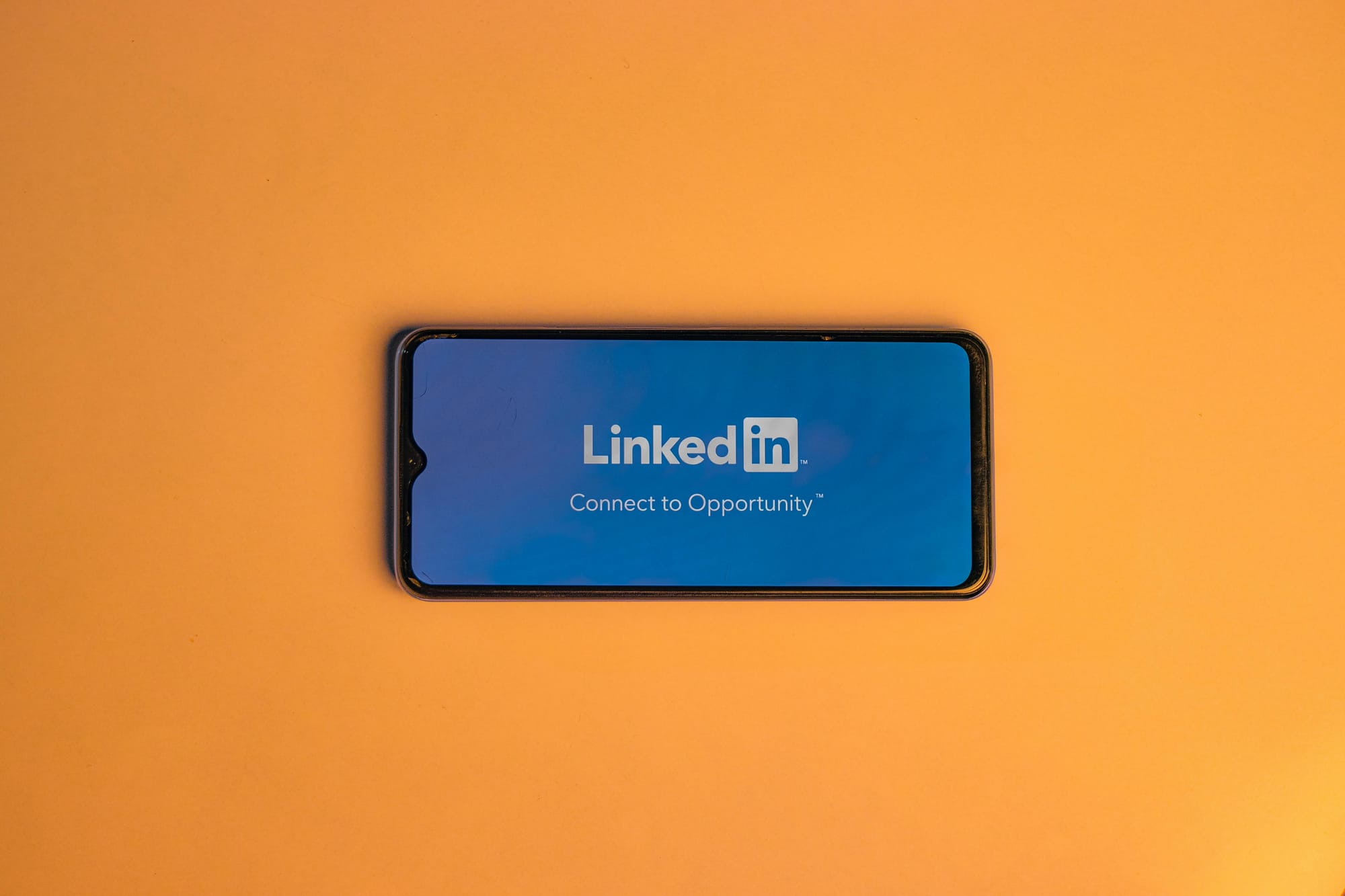
When it comes to B2B marketing and sales in 2025, LinkedIn is the undisputed MVP. If other social media platforms are like loud clubs or casual hangouts, LinkedIn is the business networking event that runs 24/7 online. It’s the place where professionals connect, and by extension, where B2B leads are ripe for the picking.
In fact, a huge chunk of B2B leads from social media come directly from LinkedIn – around 80% according to recent stat – and the vast majority of B2B marketers use LinkedIn as a primary channel. Let’s break down why LinkedIn is such a goldmine for B2B marketing (and by extension, B2B sales prospecting):
1. Professional Environment
LinkedIn users are in a business mindset—looking for solutions, sharing industry news, and open to professional conversations. That makes it ideal for B2B outreach. Unlike Facebook or Instagram, a business pitch on LinkedIn feels appropriate, not intrusive.
2. Laser-Focused Targeting
LinkedIn’s targeting is built for B2B. You can narrow down by job title, industry, seniority, company size, and more. Whether you want to reach “IT Directors at logistics firms in the UK” or “CMOs at SaaS startups,” LinkedIn lets you do it easily—especially helpful for Account-Based Marketing (ABM).
3. Powerful Use of Data
With features like Matched Audiences and retargeting, you can show ads to your dream clients by name or re-engage visitors who’ve interacted with your content. Lead Gen Form Ads make it easy for prospects to submit info without leaving LinkedIn—boosting conversions and reducing friction.
4. Variety of Ad Formats
From Sponsored Content to Message Ads, Video Ads, and Lead Gen Forms, LinkedIn offers diverse ad types to suit your campaign goals. While LinkedIn ads can be pricier, the lead quality is higher, making the return on investment better—especially for high-ticket B2B sales.
5. Organic Networking & Direct Outreach
LinkedIn is also a free prospecting and relationship-building platform. Salespeople can connect with decision-makers, join industry groups, comment on posts, and send personalized messages. It’s like having a live business directory + networking event at your fingertips.
6. Content & Thought Leadership
Posting valuable content on LinkedIn builds authority and keeps your brand top-of-mind with prospects. Since users are already in “work mode,” they’re more likely to engage with your business-related posts, articles, and videos.
Why It All Matters
LinkedIn was built for business, making it the best platform for B2B marketing. From targeted ads to personal outreach, it offers the right tools to reach decision-makers, start conversations, and generate qualified leads. In 2025, it remains the top platform for B2B growth.
Conclusion
B2B sales in 2025 is digital-first, tech-enabled, and relationship-driven. With 80% of buyer interactions happening online, a strong digital presence is essential. AI and automation streamline tasks, but human connection—trust, empathy, and tailored insight—still seals the deal.
Buyers now do most of their research before talking to sales, so reps must deliver real value. Sales, marketing, and customer success teams are aligning under RevOps for a smoother, more unified customer experience.And with younger, digital-native buyers, new communication styles like video and messaging apps are becoming the norm. Adapt, stay human, and focus on delivering value—because B2B is only getting smarter.